-
 The so-called Yoshirō-tsuba [与四郎鐔] with an iron plate of mokkō form densely decorated with floral arabesque and adorned with eight pierced, chiselled and inlaid brass roundels and signed on both sides 'Koike Yoshirō Izumi no Kami Naomasa'. Four of the roundels are pierced and have geometrical designs representing flowers (e.g. wood sorrel) or snowflakes. Four others are solid and represent family crests; on one side: Mulberry (kaji) – mon of the Matsunaga clan [松永氏], Bamboo Grass (sasa) – mon of the Takenaka clan [竹中氏]), Wild Geese (kari) – mon of the Shibata clan [新発田氏]), and Pine Needles (matsuba); on the other side: Nine Stars (kuyō) – the Hosokawa clan [細川氏], Paulownia (kiri) – the Toyotomi clan [豊臣氏]), Bamboo Leaves (take) – the Minamoto clan [源], and Seven Treasures (shippo) – Izumo Genji clan [出雲源氏]. Hitsu-ana obliterated with a nanako-treated pewter plug. Brass with rainbow patina. Artist: Koike Izumi no Kami Naomasa (Japanese, active late 16th – early 17th century). The Momoyama or early Edo period, end of the 16th to the first half of the 17th century (1574-1650). Size: 81.7 x 78.8 x 4.3 cm. Provenance: Dr. Kazutaro Torigoye. Special thanks to Markus Sesko for providing the translation of hakogaki. Hakokaki lid (outside): 小池与四郎 – Koike Yoshirō Hakokaki lid (inside): 銘曰小池与四郎 – Mei’etsu: Koike Yoshirō – Signed: Koike Yoshirō 和泉守直正 – Izumi no Kami Naomasa – Izumi no Kami Naomasa 木瓜形 鉄地 – Mokkōgata, tetsu-ji – Lobed shape, of iron 真鍮据紋象嵌 – Shinchū suemon-zōgan – with brass suemon-zōgan inlay 縦二寸七分横二寸六分 – Tate ni-sun shichi-bu, yoko ni-sun roku-bu – Height 8.2 cm, width 7.9 cm 右正真也 – Migi shōshin nari – Above described object is authentic 昭和廾九年八月十一日 – Shōwa nijūkyūnen hachigatsu jūichinichi – August 11, 1954 草堂「花押」– Sōdō + kaō – Sōdō [pen name of Torigoye Kazutarō, 鳥越一太郎] + monogram Ref.: (1) Tsuba Geijutsu-Ko by Kazutaro Torigoye, 1960; (2) Tsuba. An aesthetic study. By Kazutaro Torigoye and Robert E. Haynes from the Tsuba Geijutsu-kō of Kazataro Torigoye. Edited and published by Alan L. Harvie for the Nothern California Japanese Sword Club, 1994-1997, p. Yoshirō, 4. See also Yoshirō tsuba.
The so-called Yoshirō-tsuba [与四郎鐔] with an iron plate of mokkō form densely decorated with floral arabesque and adorned with eight pierced, chiselled and inlaid brass roundels and signed on both sides 'Koike Yoshirō Izumi no Kami Naomasa'. Four of the roundels are pierced and have geometrical designs representing flowers (e.g. wood sorrel) or snowflakes. Four others are solid and represent family crests; on one side: Mulberry (kaji) – mon of the Matsunaga clan [松永氏], Bamboo Grass (sasa) – mon of the Takenaka clan [竹中氏]), Wild Geese (kari) – mon of the Shibata clan [新発田氏]), and Pine Needles (matsuba); on the other side: Nine Stars (kuyō) – the Hosokawa clan [細川氏], Paulownia (kiri) – the Toyotomi clan [豊臣氏]), Bamboo Leaves (take) – the Minamoto clan [源], and Seven Treasures (shippo) – Izumo Genji clan [出雲源氏]. Hitsu-ana obliterated with a nanako-treated pewter plug. Brass with rainbow patina. Artist: Koike Izumi no Kami Naomasa (Japanese, active late 16th – early 17th century). The Momoyama or early Edo period, end of the 16th to the first half of the 17th century (1574-1650). Size: 81.7 x 78.8 x 4.3 cm. Provenance: Dr. Kazutaro Torigoye. Special thanks to Markus Sesko for providing the translation of hakogaki. Hakokaki lid (outside): 小池与四郎 – Koike Yoshirō Hakokaki lid (inside): 銘曰小池与四郎 – Mei’etsu: Koike Yoshirō – Signed: Koike Yoshirō 和泉守直正 – Izumi no Kami Naomasa – Izumi no Kami Naomasa 木瓜形 鉄地 – Mokkōgata, tetsu-ji – Lobed shape, of iron 真鍮据紋象嵌 – Shinchū suemon-zōgan – with brass suemon-zōgan inlay 縦二寸七分横二寸六分 – Tate ni-sun shichi-bu, yoko ni-sun roku-bu – Height 8.2 cm, width 7.9 cm 右正真也 – Migi shōshin nari – Above described object is authentic 昭和廾九年八月十一日 – Shōwa nijūkyūnen hachigatsu jūichinichi – August 11, 1954 草堂「花押」– Sōdō + kaō – Sōdō [pen name of Torigoye Kazutarō, 鳥越一太郎] + monogram Ref.: (1) Tsuba Geijutsu-Ko by Kazutaro Torigoye, 1960; (2) Tsuba. An aesthetic study. By Kazutaro Torigoye and Robert E. Haynes from the Tsuba Geijutsu-kō of Kazataro Torigoye. Edited and published by Alan L. Harvie for the Nothern California Japanese Sword Club, 1994-1997, p. Yoshirō, 4. See also Yoshirō tsuba. -
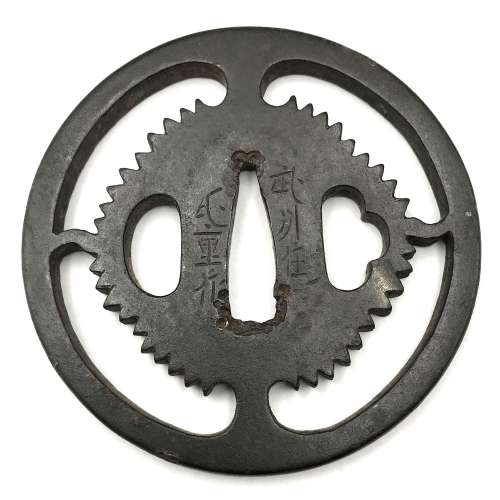 Iron tsuba of round form with slanting rays of light (shakoh) Christian motif (Jesuit's IHS symbol) in openwork (sukashi). Traditional description of this kind of design is called "tokei", or "clock gear". Edo period.
Iron tsuba of round form with slanting rays of light (shakoh) Christian motif (Jesuit's IHS symbol) in openwork (sukashi). Traditional description of this kind of design is called "tokei", or "clock gear". Edo period.Size: 83.4 x 83.1 x 4.4 mm
Signed Bushū-jū Ujishige saku (武州住氏重作) [Markus Sesko]. Ujishige (died 1677), 3rd generation of the Katsuki-Gondayu line; 1st gen. Ujiie came from Kyoto to Kaga to work for the Maeda family. There was another Ujishige, 4th generation Kaneko (?), who died in 1867 [M. Sesko, Genealogies...], but this tsuba looks a bit earlier than that. This particular Ujishige states in his signature that he is from Bushū, or Musashi Province, modern Tokyo Metropolis. He might have moved from Bushū to Kaga, of course. There is no artist with the name Ujishige in Bushū-Ito School anyway.
For information regarding shakoh tsuba see article 'Kirishitan Ikenie Tsuba by Fred Geyer at Kokusai Tosogu Kai; The 2nd International Convention & Exhibition, October 18-23, 2006, pp. 84-91. -
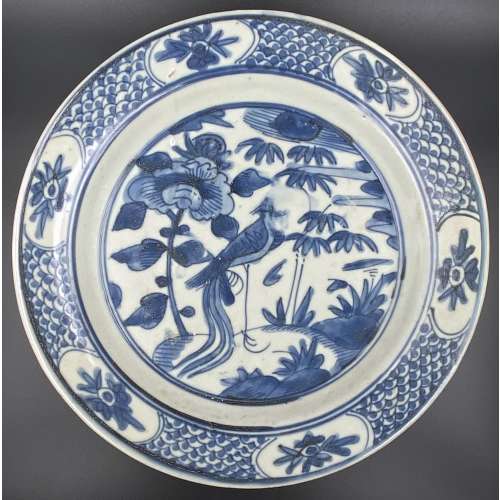 Underglaze cobalt blue and white Zhangzhou (Swatow) porcelain plate decorated vigorously and spontaneously with a bird in the landscape, and flowers in oval cartouches among waves or fish scale diaper. Sand particles on the base. Ming Dynasty [大明] (1368 – 1644); Wanli Era (1572 – 1620); Late 16th – Early 17th century. Diameter: 28.2 cm; Height: 4.0 cm
Underglaze cobalt blue and white Zhangzhou (Swatow) porcelain plate decorated vigorously and spontaneously with a bird in the landscape, and flowers in oval cartouches among waves or fish scale diaper. Sand particles on the base. Ming Dynasty [大明] (1368 – 1644); Wanli Era (1572 – 1620); Late 16th – Early 17th century. Diameter: 28.2 cm; Height: 4.0 cm -
 Iron tsuba of quatrefoil form with design of bamboo stems and leaves, and a plank bridge in openwork (sukashi). Hitsu-ana of irregular form. Iron with smooth chocolate patina. Copper and shakudō sekigane. This piece is illustrated in Sasano: Japanese Sword Guard Masterpieces from the Sasano Collection, 1994 on page 295 under № 254 with the following description:
Iron tsuba of quatrefoil form with design of bamboo stems and leaves, and a plank bridge in openwork (sukashi). Hitsu-ana of irregular form. Iron with smooth chocolate patina. Copper and shakudō sekigane. This piece is illustrated in Sasano: Japanese Sword Guard Masterpieces from the Sasano Collection, 1994 on page 295 under № 254 with the following description:Nishigaki. First generation Kanshiro (died in the sixth year of Genroku, 1693, at the age of 81). Sukashi design: Bamboo (take). Early Edo period, late 17th century (Kanbun / Enppo era). Height: 72.6 mm; Width: 71.5 mm; Rim thickness: .6 mm; Centre thickness: 5.1 mm. Rounded rim. The shape of this sword guard is a quatrefoil and the design is arranged in the form of a saddle flap. Two bamboo trunks with leaves comprise the design. Calm, soothing and sophisticated are the features of this artist in his later years. Such characteristics may remind one of the work of the first Hikozo.
Provenance: Sasano Masayuki collection, № 254. What is interesting, and what had been found by Bruce Kirkpatrick, is that in the earlier photograph of the same piece ['Sukashi tsuba - bushido no bi' by Sasano Masayuki, photography by Fujimoto Shihara, 1972 (in Japanese), page 245, №201] we clearly see kebori - linear carving that decorates the bamboo leaves and the planks of the bridge. The said kebori have totally disappeared between 1972 and 1994. The tsuba became absolutely flat! Now we can only speculate about the reasons for such cruel treatment of the artistically and historically important item.
Sukashi tsuba - bushido no bi. Author: Sasano Masayuki, photography: Fujimoto Shihara, 1972 (in Japanese). Page 245, №201.
-

Iron tsuba of round form decorated with eight roundels – circular emblems of flowers and/or family crests (mon) made of cast brass, pierced and chiseled in kebori, and with flat brass inlay (hira-zōgan) of vines or leaves all over the plate. Both hitsu-ana could have been trimmed with brass now lacking. Nakago-ana of triangular form, possibly enlarged, with copper sekigane. All typical emblems with bellflower, two variations on suhama theme, and 3, 4, 5, and 6-poinitng mon variations. A distinctive character of this tsuba is a mon at 12 hours depicting water plantain (omodaka).
“Omodaka was also called shōgunsō (victorious army grass); because of this martial connotation, it was a design favored for the crests of samurai families” [Family crests of Japan, Stone Bridge Press, Berkeley, California]. Yoshirō school (Kaga-Yoshirō). The Momoyama or early Edo period, beginning of 17th century. Size: Height: 81.4 mm; width: 81.2; thickness 3.8 mm at seppa-dai. -
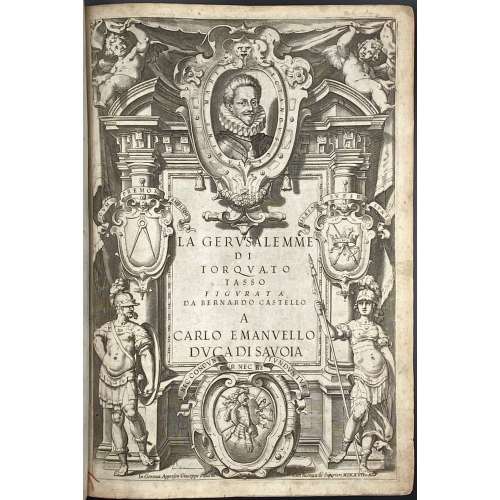 Engraved title-page 1, as per British Museum: An architectural setting with, at upper centre, a portrait of Carlo Emanuele I, Duke of Savoy, in an ornate cartouche lettered “"Spectandus Certamine Martio"; a central title “LA | GERUSALEMME | DI | TORQUATO | TASSO | FUGURATA A | DA BERNARDO CASTELLO | A | CARLO EMANUELLO | DVCA DI SAVOIA” flanked by Tuscan columns and crests with mottos and imprese showing compasses lettered "Dvm Premor Amplior", at left, and a crossed sword and sceptre with a crown lettered "Illaesa Super Sunt", at right; in the lower register, male and female figures in armour, perhaps representing Tancredi and Clorinda, with a central crest showing an impresa of armour”. Central title: Below, within frame: "In Genova, Appresso Giuseppe Pavoni. […] Con licenza de' Superiori. MDCXVII." Engraved title-page 2, as per British Museum: Portrait of Torquato Tasso, bust, facing front, wearing a laurel crown; within an oval pendant, lettered “TOROVATO […] TASSO EF”, suspended from a pediment, beneath which a view of Genoa is flanked by two columns, and above is a tablet, lettered: “LA GERUSALEMME | LIBERATA | DI TORQUATO | TASSO. | Con le annotazioni | di Scipion | Gentili, e di Givlio | Guastauini , | Et li argomenti di Oratio Ariosti , | STAMPATA | Per Giuseppe Pauoni ad instanza di | Bernardo Castello,in Genova | L’Anno MDCXVII." Collation: 8vo; 2 leaves of engraved title-pages, 1 leaf signed †2, 1 leaf unsigned, 2 leaves signed †† and ††2, respectively, 1 leaf unsigned, 1 leaf with engraving to verso (frontispiece to Canto Primo) —> 8 prelims (besides FEP or a blank leaf before 1st t.p.); π8 A-Q8 (pp. 1-255 [256 blank], plated within collation), G1, I1, K1, O1, and P1 (recto to plates without text) unsigned, L3 signed as second L2; A-D8 E4 (pp. 1-71 [72]; A-B8 C4 χ1 (pp. [1] 2-36 [37-40] [2]), in the 4-leaf quires E and C only two first leaves signed, in the 8-leaf quires four first leaves signed. Illustrations: woodcut head- and tail-pieces, woodcut initials, some historiated, and 20 plates within collation and pagination engraved by Camillo Cungio after Bernardo Castello. Binding: 30.5 x 21.4 cm overall, 30 x 20.5 cm leaves; contemporary vellum, rebacked with modern brown morocco, crimson morocco label with gilt lettering and double-fillet outline. Two bookplates to front pastedown: (1) Chippendale armorial bookplate (8.3 x 7.6 cm): Thos. Brand Esqr. Signed: W Austin — Fecit; (2) The Robin Collection bookplate. Bookseller’s ticket to back pastedown: “J. POOLE. | British & foreign | BOOKSELLER, | 39 BOOKSELLERS ROW, | STRAND |〰️| Books Bought.” All edges green. Provenance: The Robin Collection; Thomas Brand Hollis (British, 1719 – 1804). Contributors: Torquato Tasso (Italian, 1544 –1595) – author. Scipione Gentili [Scipio Gentilis] (Italian, 1563 – 1616) – author. Giulio Guastavini (Italian, fl. 16th century) – author. Bernardo Castello [Castelli] (Italian, 1557 – 1629) – artist. Camillo Cungi (Italian, fl. 1597 – 1649) – engraver. Giuseppe Pavoni (Italian, 1551 – c. 1641) – printer, publisher. Carlo Emanuele I, Duke of Savoy (Italian, 1562 – 1630) – dedicatee.
Engraved title-page 1, as per British Museum: An architectural setting with, at upper centre, a portrait of Carlo Emanuele I, Duke of Savoy, in an ornate cartouche lettered “"Spectandus Certamine Martio"; a central title “LA | GERUSALEMME | DI | TORQUATO | TASSO | FUGURATA A | DA BERNARDO CASTELLO | A | CARLO EMANUELLO | DVCA DI SAVOIA” flanked by Tuscan columns and crests with mottos and imprese showing compasses lettered "Dvm Premor Amplior", at left, and a crossed sword and sceptre with a crown lettered "Illaesa Super Sunt", at right; in the lower register, male and female figures in armour, perhaps representing Tancredi and Clorinda, with a central crest showing an impresa of armour”. Central title: Below, within frame: "In Genova, Appresso Giuseppe Pavoni. […] Con licenza de' Superiori. MDCXVII." Engraved title-page 2, as per British Museum: Portrait of Torquato Tasso, bust, facing front, wearing a laurel crown; within an oval pendant, lettered “TOROVATO […] TASSO EF”, suspended from a pediment, beneath which a view of Genoa is flanked by two columns, and above is a tablet, lettered: “LA GERUSALEMME | LIBERATA | DI TORQUATO | TASSO. | Con le annotazioni | di Scipion | Gentili, e di Givlio | Guastauini , | Et li argomenti di Oratio Ariosti , | STAMPATA | Per Giuseppe Pauoni ad instanza di | Bernardo Castello,in Genova | L’Anno MDCXVII." Collation: 8vo; 2 leaves of engraved title-pages, 1 leaf signed †2, 1 leaf unsigned, 2 leaves signed †† and ††2, respectively, 1 leaf unsigned, 1 leaf with engraving to verso (frontispiece to Canto Primo) —> 8 prelims (besides FEP or a blank leaf before 1st t.p.); π8 A-Q8 (pp. 1-255 [256 blank], plated within collation), G1, I1, K1, O1, and P1 (recto to plates without text) unsigned, L3 signed as second L2; A-D8 E4 (pp. 1-71 [72]; A-B8 C4 χ1 (pp. [1] 2-36 [37-40] [2]), in the 4-leaf quires E and C only two first leaves signed, in the 8-leaf quires four first leaves signed. Illustrations: woodcut head- and tail-pieces, woodcut initials, some historiated, and 20 plates within collation and pagination engraved by Camillo Cungio after Bernardo Castello. Binding: 30.5 x 21.4 cm overall, 30 x 20.5 cm leaves; contemporary vellum, rebacked with modern brown morocco, crimson morocco label with gilt lettering and double-fillet outline. Two bookplates to front pastedown: (1) Chippendale armorial bookplate (8.3 x 7.6 cm): Thos. Brand Esqr. Signed: W Austin — Fecit; (2) The Robin Collection bookplate. Bookseller’s ticket to back pastedown: “J. POOLE. | British & foreign | BOOKSELLER, | 39 BOOKSELLERS ROW, | STRAND |〰️| Books Bought.” All edges green. Provenance: The Robin Collection; Thomas Brand Hollis (British, 1719 – 1804). Contributors: Torquato Tasso (Italian, 1544 –1595) – author. Scipione Gentili [Scipio Gentilis] (Italian, 1563 – 1616) – author. Giulio Guastavini (Italian, fl. 16th century) – author. Bernardo Castello [Castelli] (Italian, 1557 – 1629) – artist. Camillo Cungi (Italian, fl. 1597 – 1649) – engraver. Giuseppe Pavoni (Italian, 1551 – c. 1641) – printer, publisher. Carlo Emanuele I, Duke of Savoy (Italian, 1562 – 1630) – dedicatee. -
 Iron tsuba of round form inlaid with brass, copper, and shakudō wire fastened to the surface with metal staples (mukade-zōgan); Scalloped brass inlay around the rim. Early Edo, 17th century. Height: 84.8 mm; Width 84.8 mm; Thickness at seppa-dai: 3.7 mm. Weight 161.6 g. Design is thought to resemble a centipede. "Centipede-like inlay (mukade zogan) of alternating iron and brass staples produce an appearance that was particularly favored by Takeda Shingen (1521-1573), one of the most powerful warlords of his time. The centipede is sacred to Bishamon (God of War) and especially propitious for a warrior. Shingen type, 16th century.” [The Peabody Museum collection of Japanese sword guards with selected pieces of sword furniture, by John D. Hamilton. Photographs by Mark Sexton. Salem, MA, 1975.] See also: http://varshavskycollection.com/shingen-tsuba/
Iron tsuba of round form inlaid with brass, copper, and shakudō wire fastened to the surface with metal staples (mukade-zōgan); Scalloped brass inlay around the rim. Early Edo, 17th century. Height: 84.8 mm; Width 84.8 mm; Thickness at seppa-dai: 3.7 mm. Weight 161.6 g. Design is thought to resemble a centipede. "Centipede-like inlay (mukade zogan) of alternating iron and brass staples produce an appearance that was particularly favored by Takeda Shingen (1521-1573), one of the most powerful warlords of his time. The centipede is sacred to Bishamon (God of War) and especially propitious for a warrior. Shingen type, 16th century.” [The Peabody Museum collection of Japanese sword guards with selected pieces of sword furniture, by John D. Hamilton. Photographs by Mark Sexton. Salem, MA, 1975.] See also: http://varshavskycollection.com/shingen-tsuba/ -
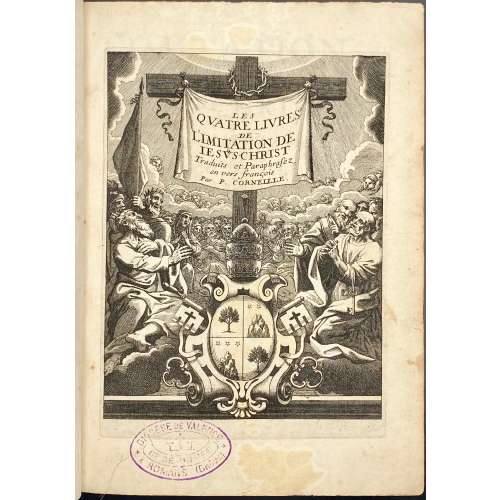 L'Imitation de Jésus-Christ / Traduite et paraphrasée en Vers François Par P. Corneille. — A Paris, Chez Pierre Rocolet, Imprimeur & Libraire ordinaire du Roy, au Palais, en la Gallerie des Prisonniers, aux Armes du Roy & de la Ville. M. DC. LVI. Avec Approbation des Docteurs, et Privelege de sa Majesté. Paris: Pierre Rocolet, 1656. Half-title: Les Quatre Livres de L'Imitation de Iesus-Christ. Traduites et paraphrasez en vers françois Par P. Corneille. — pp.: ff [2 pictorial ht, verso blank] [2 title, blank] [10 epistre] [2 av lecteur] [2 approbation, frontis.] 1-551 [552-60 table, privilege] bf. 8vo, 24.7 x 18.7 cm, hardcover; full speckled brown calf, gilt double-ruled boards, spine with raised bands, gilt double-ruled compartments with lozenges, sprayed margins; pages darkened. Purple ink stamp of Diocèse de Valencia to half-title. Nut ink ex libris handwriting on front paste-down. Plates: Half-title: unsigned copper engraving with the coat of arms of Pope Alexander VII (r. 1655 – 1667) which contains an oak tree in the top left and bottom right quarters (from Della Rovere family, Dukes of Urbino), the top right and bottom left quarters feature a mountain of six coupeaux in base with three stars above (from Chigi family). Four copper engravings inbound at the beginning of each book signed 'F. Chauueau in et fe.': Page 1: Jesus teaches His disciple. Page 113: Annunciation. Page 183: Jesus meets Simon called Peter and his brother Andrew. Page 459: Last Supper. François Chauveau (10 May 1613, Paris – 3 February 1676, Paris), a French painter and engraver. Thomas à Kempis (c. 1380 – 25 July 1471), a German-Dutch canon regular. Pierre Corneille (1606 – 1684), a French poet and playwright. Pierre Rocolet (1610 – 1662, active circa 1638 à 1662), a French publisher and printer.
L'Imitation de Jésus-Christ / Traduite et paraphrasée en Vers François Par P. Corneille. — A Paris, Chez Pierre Rocolet, Imprimeur & Libraire ordinaire du Roy, au Palais, en la Gallerie des Prisonniers, aux Armes du Roy & de la Ville. M. DC. LVI. Avec Approbation des Docteurs, et Privelege de sa Majesté. Paris: Pierre Rocolet, 1656. Half-title: Les Quatre Livres de L'Imitation de Iesus-Christ. Traduites et paraphrasez en vers françois Par P. Corneille. — pp.: ff [2 pictorial ht, verso blank] [2 title, blank] [10 epistre] [2 av lecteur] [2 approbation, frontis.] 1-551 [552-60 table, privilege] bf. 8vo, 24.7 x 18.7 cm, hardcover; full speckled brown calf, gilt double-ruled boards, spine with raised bands, gilt double-ruled compartments with lozenges, sprayed margins; pages darkened. Purple ink stamp of Diocèse de Valencia to half-title. Nut ink ex libris handwriting on front paste-down. Plates: Half-title: unsigned copper engraving with the coat of arms of Pope Alexander VII (r. 1655 – 1667) which contains an oak tree in the top left and bottom right quarters (from Della Rovere family, Dukes of Urbino), the top right and bottom left quarters feature a mountain of six coupeaux in base with three stars above (from Chigi family). Four copper engravings inbound at the beginning of each book signed 'F. Chauueau in et fe.': Page 1: Jesus teaches His disciple. Page 113: Annunciation. Page 183: Jesus meets Simon called Peter and his brother Andrew. Page 459: Last Supper. François Chauveau (10 May 1613, Paris – 3 February 1676, Paris), a French painter and engraver. Thomas à Kempis (c. 1380 – 25 July 1471), a German-Dutch canon regular. Pierre Corneille (1606 – 1684), a French poet and playwright. Pierre Rocolet (1610 – 1662, active circa 1638 à 1662), a French publisher and printer. -
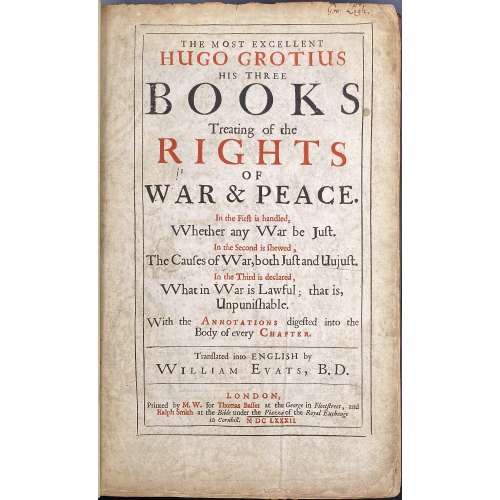 Volume collated 4to, 32.5 x 21 cm, later full calf, blind-tooled boards, sunned, raised bands and gilt lettering to spine. bound without the additional engraved title-page sometimes present; title printed in black and red, woodcut headpieces and initials; a little foxing (mostly marginal) throughout, title lightly dust stained with slight chipping at extremities, minor marginal worming to early leaves (b3-I4), paper flaw to outer margin of E1; contemporary English ownership inscription of George Legh to the title, a handful of manuscript corrections to text and annotations to index. Title-page (double frame, red and black, tall ‘s’): THE MOST EXCELLENT | HUGO GROTIUS | HIS THREE | BOOKS | Treating of the | RIGHTS | OF | WAR & PEACE. | In the First is handled, | Whether any War be Just. | In the Second is shewed , | The Causes of War, both Just and Uujust (sic). | In the Third is declared , | What in War is Lawful ; that is, | Unpunishable. | With the Annotations digested into the | Body of every Chapter. | — | Translated into ENGLISH by | William Evats, B. D. | — | LONDON, | Printed by M. W. for Thomas Basset at the George in Fleetstreet, and | Ralph Smith at the Bible under the Piazza of the Royal Exchange | in Cornhill. M DC LXXXII. || Collation: A4 a-b4 c3 B-Z4 2A-2D4 2E6 3A-3Z4 4A-4D4 4E-4L2; total 247 leaves as called for; lacking engraved title-page. Pagination: [4] i-xxi [5] 1-220 (text continuous) 361-572 [573] [574 blank] [30 table]; total 494 pages. Seller’s note: First edition of the first complete English translation, following Barksdale’s abridgement, of Grotius’s landmark work of political philosophy, the first treatise on international law. First published in Latin in 1625, Grotius’s De iure belli ac pacis “became the basic manual for both the theoretical justification and the entire practice of the international law of war as well as of international law in general for the whole period of the ancien régime in Europe” [Duchhardt, p. 288]. “It would be hard to imagine any work more central to the intellectual world of the Enlightenment … [By] the time of the post-First World War settlement, Grotius was regarded almost exclusively as the founder of modern civilized interstate relations, and as a suitable tutelary presence for the new Peace Palace at The Hague … [In] some ways that was to radically misunderstand Grotius’s views on war; he was in fact much more of an apologist for aggression and violence than many of his more genuinely innovative qualities of his moral theory, qualities that entitle him to an essential place in the history of political theory …” [Tuck, pp. xi-xii]. Contributors: Hugo Grotius (Dutch, 1583 – 1645) – author. William Evats (British, c.1606 – 1677) – translator. Margaret White (British, fl. 1678 – 1683) – printer. Thomas Bassett (British, fl. c. 1659 – 1693) – publisher/bookseller. Ralph Smith (British, fl. 1642 – 1684) – publisher/bookseller.
Volume collated 4to, 32.5 x 21 cm, later full calf, blind-tooled boards, sunned, raised bands and gilt lettering to spine. bound without the additional engraved title-page sometimes present; title printed in black and red, woodcut headpieces and initials; a little foxing (mostly marginal) throughout, title lightly dust stained with slight chipping at extremities, minor marginal worming to early leaves (b3-I4), paper flaw to outer margin of E1; contemporary English ownership inscription of George Legh to the title, a handful of manuscript corrections to text and annotations to index. Title-page (double frame, red and black, tall ‘s’): THE MOST EXCELLENT | HUGO GROTIUS | HIS THREE | BOOKS | Treating of the | RIGHTS | OF | WAR & PEACE. | In the First is handled, | Whether any War be Just. | In the Second is shewed , | The Causes of War, both Just and Uujust (sic). | In the Third is declared , | What in War is Lawful ; that is, | Unpunishable. | With the Annotations digested into the | Body of every Chapter. | — | Translated into ENGLISH by | William Evats, B. D. | — | LONDON, | Printed by M. W. for Thomas Basset at the George in Fleetstreet, and | Ralph Smith at the Bible under the Piazza of the Royal Exchange | in Cornhill. M DC LXXXII. || Collation: A4 a-b4 c3 B-Z4 2A-2D4 2E6 3A-3Z4 4A-4D4 4E-4L2; total 247 leaves as called for; lacking engraved title-page. Pagination: [4] i-xxi [5] 1-220 (text continuous) 361-572 [573] [574 blank] [30 table]; total 494 pages. Seller’s note: First edition of the first complete English translation, following Barksdale’s abridgement, of Grotius’s landmark work of political philosophy, the first treatise on international law. First published in Latin in 1625, Grotius’s De iure belli ac pacis “became the basic manual for both the theoretical justification and the entire practice of the international law of war as well as of international law in general for the whole period of the ancien régime in Europe” [Duchhardt, p. 288]. “It would be hard to imagine any work more central to the intellectual world of the Enlightenment … [By] the time of the post-First World War settlement, Grotius was regarded almost exclusively as the founder of modern civilized interstate relations, and as a suitable tutelary presence for the new Peace Palace at The Hague … [In] some ways that was to radically misunderstand Grotius’s views on war; he was in fact much more of an apologist for aggression and violence than many of his more genuinely innovative qualities of his moral theory, qualities that entitle him to an essential place in the history of political theory …” [Tuck, pp. xi-xii]. Contributors: Hugo Grotius (Dutch, 1583 – 1645) – author. William Evats (British, c.1606 – 1677) – translator. Margaret White (British, fl. 1678 – 1683) – printer. Thomas Bassett (British, fl. c. 1659 – 1693) – publisher/bookseller. Ralph Smith (British, fl. 1642 – 1684) – publisher/bookseller. -
 Relatively thick iron tsuba of rounded square form with slightly elevated rim decorated in carving (sukidashi-bori) and yellow brass (shinchū) inlay (suemon-zōgan) with legendary creatures (humans with cow heads) in a pine tree forrest on the face, and a horned man with a stick hunting a rabbit in the woods on the reverse. Large hitsu-ana possibly cut off later on. In the beginning of the 20th century such tsuba were usually attributed to Fushimi-Kaga school. This one may be attributed to either Ōnin or to Heianjō. The latter seems most plosible because of the thick web and dull patina. The technique may also be called "shinchū-zōgan". Momoyama or early Edo period. Unsigned. Dimensions: 72.3 x 68.4 x 4.1 mm
Relatively thick iron tsuba of rounded square form with slightly elevated rim decorated in carving (sukidashi-bori) and yellow brass (shinchū) inlay (suemon-zōgan) with legendary creatures (humans with cow heads) in a pine tree forrest on the face, and a horned man with a stick hunting a rabbit in the woods on the reverse. Large hitsu-ana possibly cut off later on. In the beginning of the 20th century such tsuba were usually attributed to Fushimi-Kaga school. This one may be attributed to either Ōnin or to Heianjō. The latter seems most plosible because of the thick web and dull patina. The technique may also be called "shinchū-zōgan". Momoyama or early Edo period. Unsigned. Dimensions: 72.3 x 68.4 x 4.1 mm -
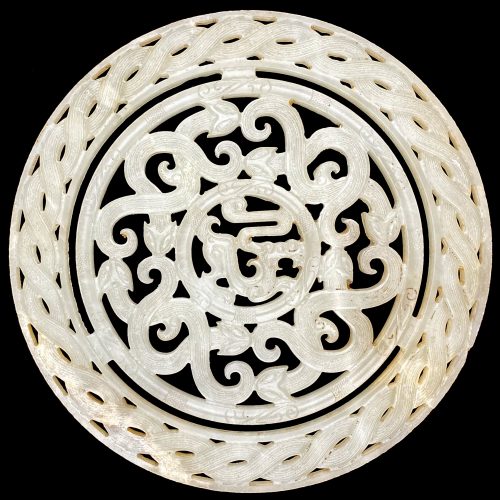 White jade Bi of three concentrical circles: double helix outer, intertwined serpents in the middle and a dragon in centre, carved in openwork and low-relief. China, the Ming Dynasty [大明] (1368 – 1644). Diameter: 15.9 cm; Height: 0.5 cm.
White jade Bi of three concentrical circles: double helix outer, intertwined serpents in the middle and a dragon in centre, carved in openwork and low-relief. China, the Ming Dynasty [大明] (1368 – 1644). Diameter: 15.9 cm; Height: 0.5 cm. -
 Iron tsuba of round form decorated with eight roundels – circular emblems of flowers and/or family crests (mon) made of cast brass, pierced and chiseled in kebori, and with flat brass inlay (hira-zōgan) of vines or leaves all over the plate. Both hitsu-ana trimmed in brass. Nakago-ana of rectangular form, with copper sekigane. Four positive openwork (ji-sukashi) roundels at 12, 3, 6, and 9 o'clock; and four negative openwork (in-sukashi) roundels with cherry blossom, bellflower, and two variations on suhama theme. Yoshirō school (Kaga-Yoshirō). The Momoyama or early Edo period, late 16th to early 17th century. Size: diameter 81.4 mm, thickness 4.7 mmat seppa-dai, 4.0 mm at rim. Christie's lot description: AN IRON TSUBA; EDO PERIOD (17TH CENTURY). THE DOLPHYN COLLECTION OF SAMURAI ART. The round iron tsuba pierced with roundels of various floral motifs interspersed among scrolling foliage, all inlaid with brass. 8.1 cm. high. Provenance: Pabst Collection (no. 338).
Iron tsuba of round form decorated with eight roundels – circular emblems of flowers and/or family crests (mon) made of cast brass, pierced and chiseled in kebori, and with flat brass inlay (hira-zōgan) of vines or leaves all over the plate. Both hitsu-ana trimmed in brass. Nakago-ana of rectangular form, with copper sekigane. Four positive openwork (ji-sukashi) roundels at 12, 3, 6, and 9 o'clock; and four negative openwork (in-sukashi) roundels with cherry blossom, bellflower, and two variations on suhama theme. Yoshirō school (Kaga-Yoshirō). The Momoyama or early Edo period, late 16th to early 17th century. Size: diameter 81.4 mm, thickness 4.7 mmat seppa-dai, 4.0 mm at rim. Christie's lot description: AN IRON TSUBA; EDO PERIOD (17TH CENTURY). THE DOLPHYN COLLECTION OF SAMURAI ART. The round iron tsuba pierced with roundels of various floral motifs interspersed among scrolling foliage, all inlaid with brass. 8.1 cm. high. Provenance: Pabst Collection (no. 338). -
 Iron tsuba of round form decorated with eight roundels – circular emblems of flowers and/or family crests (mon) made of cast brass, pierced and chiselled in kebori, and with flat brass inlay (hira-zōgan) of vines or leaves all over the plate. Both hitsu-ana trimmed with brass. Nakago-ana of trapezoidal form. A distinctive character of this tsuba is a mon at 6 hours depicting tomoe (comma). Yoshirō school (Kaga-Yoshirō). Attributed to Koike Yoshirō Naomasa himself. Unsigned. The Momoyama or early Edo period, end of the 16th to the first half of the 17th century (1574-1650). Size: Diameter 82.0 mm, thickness 3.8 mm at seppa-dai, 3.4 mm at rim.
Iron tsuba of round form decorated with eight roundels – circular emblems of flowers and/or family crests (mon) made of cast brass, pierced and chiselled in kebori, and with flat brass inlay (hira-zōgan) of vines or leaves all over the plate. Both hitsu-ana trimmed with brass. Nakago-ana of trapezoidal form. A distinctive character of this tsuba is a mon at 6 hours depicting tomoe (comma). Yoshirō school (Kaga-Yoshirō). Attributed to Koike Yoshirō Naomasa himself. Unsigned. The Momoyama or early Edo period, end of the 16th to the first half of the 17th century (1574-1650). Size: Diameter 82.0 mm, thickness 3.8 mm at seppa-dai, 3.4 mm at rim. -
 Title-page: AMINTA | FAVOLA BOSCARECCIA | DI | TORQUATO TASSO | CON | LE ANNOTATIONI | D'EGIDIO MENAGIO | ACCADEMICO | DELLA CRVSCA• | {woodcut vignette} | IN PARIGI| Presso AGOSTINO Cvrbe`, nella Galeria del Palazzo, | all’ insegna della Palma. |—| M. DC. LV. || Collation: 4to; ā4 ē4 ī4 A2 B2 C-V4 Y-Z4 2A1,2 X4 2A3,4 2B-2Z4, 3A-3B4, total number of leaves = 200. Note: O2, 2K3, 2V3 2X3 2Y3, and 3B3 – unsigned, 2Z3 signed 2Z2 (Zzij), quire X (pp. 145-152) bound between 2A2 (p. 172) and 2A3 (p. 173); illustrated throughout with woodcut head- and tailpieces and initials, Atto Primo has copperplate engraved historiated initial and a headpiece signed “F. C. in. — I. B. fe.” “I. B.” was a monogram of engraver Giulio Bonasone (Italian, c. 1498 – after 1574). Pagination: [2] – t.p. / blank, [8] – dedication, i-xviii, [4], 1-341 [342-368]; total number of pages = 400. Binding: 22.3 x 18 cm, 19th-century quarter morocco over marbled boards, spine with raised bands and gilt lettering, rebacked, additional blank flyleaves at front and back, marbled endpapers and all edges. Bookplate to front pastedown: “The Robin Collection”. Verso front flyleaf stamped “RESTORED BY MACDONALD CO. | NORWALK. CONN. Provenance: The Robin Collection. Contributors: Torquato Tasso (Italian, 1544 –1595) – author. Gilles Ménage (French, 1613 – 1692) – author. Antoine Vitré (French, 1595 – 1674) – printer. Augustin Courbé (French, fl. c. 1625 – 1660) – publisher. Marie-Madeleine Pioche de La Vergne, comtesse de La Fayette (French, 1634 – 1693) – dedicatee.
Title-page: AMINTA | FAVOLA BOSCARECCIA | DI | TORQUATO TASSO | CON | LE ANNOTATIONI | D'EGIDIO MENAGIO | ACCADEMICO | DELLA CRVSCA• | {woodcut vignette} | IN PARIGI| Presso AGOSTINO Cvrbe`, nella Galeria del Palazzo, | all’ insegna della Palma. |—| M. DC. LV. || Collation: 4to; ā4 ē4 ī4 A2 B2 C-V4 Y-Z4 2A1,2 X4 2A3,4 2B-2Z4, 3A-3B4, total number of leaves = 200. Note: O2, 2K3, 2V3 2X3 2Y3, and 3B3 – unsigned, 2Z3 signed 2Z2 (Zzij), quire X (pp. 145-152) bound between 2A2 (p. 172) and 2A3 (p. 173); illustrated throughout with woodcut head- and tailpieces and initials, Atto Primo has copperplate engraved historiated initial and a headpiece signed “F. C. in. — I. B. fe.” “I. B.” was a monogram of engraver Giulio Bonasone (Italian, c. 1498 – after 1574). Pagination: [2] – t.p. / blank, [8] – dedication, i-xviii, [4], 1-341 [342-368]; total number of pages = 400. Binding: 22.3 x 18 cm, 19th-century quarter morocco over marbled boards, spine with raised bands and gilt lettering, rebacked, additional blank flyleaves at front and back, marbled endpapers and all edges. Bookplate to front pastedown: “The Robin Collection”. Verso front flyleaf stamped “RESTORED BY MACDONALD CO. | NORWALK. CONN. Provenance: The Robin Collection. Contributors: Torquato Tasso (Italian, 1544 –1595) – author. Gilles Ménage (French, 1613 – 1692) – author. Antoine Vitré (French, 1595 – 1674) – printer. Augustin Courbé (French, fl. c. 1625 – 1660) – publisher. Marie-Madeleine Pioche de La Vergne, comtesse de La Fayette (French, 1634 – 1693) – dedicatee. -
 Iron tsuba of round form with circular iron wire fastened to the surface with iron and brass staples (mukade-zōgan); brass ring about 2.5 mm wide along the rim with chisel marks. Design repeats on the reverse. Copper sekigane. Early Edo, 17th century. Size: Height: 83.3 mm; width 83.9 mm; thickness at seppa-dai: 4.5 mm. Weight 173.6 g. Design is thought to resemble a centipede. "Centipede-like inlay (mukade zogan) of alternating iron and brass staples produce an appearance that was particularly favored by Takeda Shingen (1521-1573), one of the most powerful warlords of his time. The centipede is sacred to Bishamon (God of War) and especially propitious for a warrior. Shingen type, 16th century.” [The Peabody Museum collection of Japanese sword guards with selected pieces of sword furniture, by John D. Hamilton. Photographs by Mark Sexton. Salem, MA, 1975.] See also: http://varshavskycollection.com/shingen-tsuba/ SOLD
Iron tsuba of round form with circular iron wire fastened to the surface with iron and brass staples (mukade-zōgan); brass ring about 2.5 mm wide along the rim with chisel marks. Design repeats on the reverse. Copper sekigane. Early Edo, 17th century. Size: Height: 83.3 mm; width 83.9 mm; thickness at seppa-dai: 4.5 mm. Weight 173.6 g. Design is thought to resemble a centipede. "Centipede-like inlay (mukade zogan) of alternating iron and brass staples produce an appearance that was particularly favored by Takeda Shingen (1521-1573), one of the most powerful warlords of his time. The centipede is sacred to Bishamon (God of War) and especially propitious for a warrior. Shingen type, 16th century.” [The Peabody Museum collection of Japanese sword guards with selected pieces of sword furniture, by John D. Hamilton. Photographs by Mark Sexton. Salem, MA, 1975.] See also: http://varshavskycollection.com/shingen-tsuba/ SOLD -
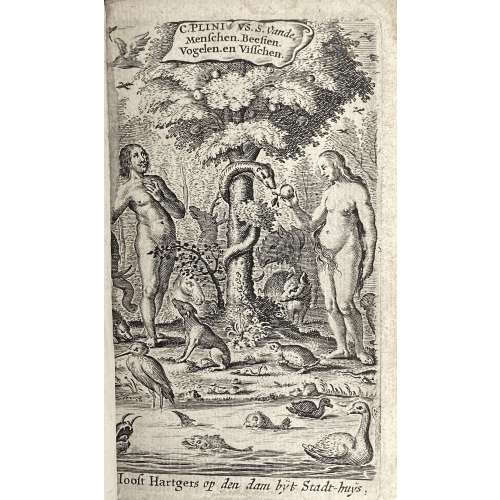 Pliny's Historia Naturalis. Engraved Title: C. PLINIUS S. Vande Menfchen, Beeften, Vogelen en Viffchen. [Pliny the Elder. Of Men, Beasts, Birds, and Fish]. Title: C. PLINII | SECUNDI | Des wijd-vermaerden Na- | tuur-kondigers vijf boecken handelende van de nature. | Handelende van de Nature | I. Vande Manfchen. | II. Vande viervoetige en kruypende Dieren. | III. Vande Vogelen. | IV. Vande kleyne Beeftjes of Ongedierten. | V. Vande Viffchen, Oefters, Kreeften, &c. | Hier zijn by ghevoeght / de Schriften | van verscheyden andere oude autheuren / de | natuer der dieren aengaende; | En nu in defen leften Druck wel het vierde part | vermeerdert , uyt verscheyden nieuwe Schrijvers | en eyghen ondervindinge : en met veel | kopere Plaeten verciert. {Device} | t' AMSTELREDAM , | By Iooft Hartgers, Boeck-verkooper op den Dam | bezijden het Stadthuys, 1650. Pagination: [1, 2] - engraved t.p. / blank, [3, 4] - text t.p. / Aen den nauw-keuringem Lefer..., 5-802, 52 engraved plates; colophon on p. 802 bottom: "Gedruckt by Chiftoffel Cunradus, ..." Collation: A-Z1-12, Aa-Kk1-12 Size: 12mo, 14 x 9 cm Binding: Vellum The first Dutch version, consisting of extracts from books 7-11 from Pliny's "Natural History" was published in Arnheim by Jans Janzen in quarto in 1610. Our copy is one of the Amsterdam editions and the only one in duodecimo. According to WorldCat, there is not a single copy of this edition in the US libraries. Printed by Christoffel Cunradus ( Freiberg , c. 1615 - Amsterdam , 1684) for publisher Joost Hartgers (Dutch, fl. 1650). See Gudger, E. W. "Pliny's Historia Naturalis. The Most Popular Natural History Ever Published." Isis 6, no. 3 (1924): 269-81. Accessed September 23, 2020. http://www.jstor.org/stable/224311.
Pliny's Historia Naturalis. Engraved Title: C. PLINIUS S. Vande Menfchen, Beeften, Vogelen en Viffchen. [Pliny the Elder. Of Men, Beasts, Birds, and Fish]. Title: C. PLINII | SECUNDI | Des wijd-vermaerden Na- | tuur-kondigers vijf boecken handelende van de nature. | Handelende van de Nature | I. Vande Manfchen. | II. Vande viervoetige en kruypende Dieren. | III. Vande Vogelen. | IV. Vande kleyne Beeftjes of Ongedierten. | V. Vande Viffchen, Oefters, Kreeften, &c. | Hier zijn by ghevoeght / de Schriften | van verscheyden andere oude autheuren / de | natuer der dieren aengaende; | En nu in defen leften Druck wel het vierde part | vermeerdert , uyt verscheyden nieuwe Schrijvers | en eyghen ondervindinge : en met veel | kopere Plaeten verciert. {Device} | t' AMSTELREDAM , | By Iooft Hartgers, Boeck-verkooper op den Dam | bezijden het Stadthuys, 1650. Pagination: [1, 2] - engraved t.p. / blank, [3, 4] - text t.p. / Aen den nauw-keuringem Lefer..., 5-802, 52 engraved plates; colophon on p. 802 bottom: "Gedruckt by Chiftoffel Cunradus, ..." Collation: A-Z1-12, Aa-Kk1-12 Size: 12mo, 14 x 9 cm Binding: Vellum The first Dutch version, consisting of extracts from books 7-11 from Pliny's "Natural History" was published in Arnheim by Jans Janzen in quarto in 1610. Our copy is one of the Amsterdam editions and the only one in duodecimo. According to WorldCat, there is not a single copy of this edition in the US libraries. Printed by Christoffel Cunradus ( Freiberg , c. 1615 - Amsterdam , 1684) for publisher Joost Hartgers (Dutch, fl. 1650). See Gudger, E. W. "Pliny's Historia Naturalis. The Most Popular Natural History Ever Published." Isis 6, no. 3 (1924): 269-81. Accessed September 23, 2020. http://www.jstor.org/stable/224311. -
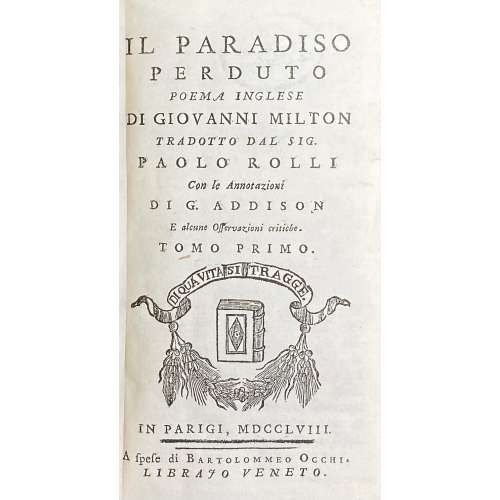 Quarter calf over marbled boards, 16 x 9 cm, spine with raised bands, gilt in compartments, gilt-lettered label, all margins red, two title-pages (one for each vol.), illustrated with engraved frontispiece by Antonio Baratti after Antonio Balestra; engraved portrait of John Milton by Antonio Baratti, 12 plates, one for each book, after “Piazzetta, Zucchi, Balestra, Tiepolo, and other Venetian artists”, unsigned; plate II signed ‘Antonio Barati scul.’ Title page: IL PARADISO | PERDUTO | POEMA INGLESE | DI GIOVANNI MILTON | TRADOTTO DAL SIG. | PAOLO ROLLI | Con le Annotazioni | DI G. ADDISON | E alcune Osservazioni critiche. | TOMO PRIMO (SECUNDO). | {publisher’s device} | IN PARIGI , MDCCLVIII. | — | A spese di Bartolommeo Occhi. | LIBRAJO VENETO. || Collation: *-**12 ***8 (dedication, vita), A-R12 (vol. 1) A-K12 L9 (vol.2); total 365 leaves plus 14 engraved plates, incl. frontispiece and portrait. Pagination: [i, ii] iii-lxiv 1-407 [408 blank], [2] 3-258; total 730 pages. Catalogue raisonné: Wickenheiser Collection 688 [LIB-2795.2021]. Though it states 228 pp., which does not seem right. “Scarce. Not in Coleridge”. Contributors: Milton, John (British, 1608 – 1674) – author. Joseph Addison (British, 1672 – 1719) – author / criticism Paolo Antonio Rolli (Italian, 1687 – 1765) – author / transaltion Bartolomeo Occhi (Italian, 1730 – 1781) – publisher. Antonio Baratti (Italian, 1724 – 1787) – engraver Antonio Balestra (Italian, 1666 – 1740) – artist. Giovanni Battista Piazzetta (Italian,1682/83 – 1754) – artist. Antonio Zucchi (Italian, 1726 – 1795) – artist. Giovanni Battista Tiepolo (Italian, 1696 – 1770) – artist.
Quarter calf over marbled boards, 16 x 9 cm, spine with raised bands, gilt in compartments, gilt-lettered label, all margins red, two title-pages (one for each vol.), illustrated with engraved frontispiece by Antonio Baratti after Antonio Balestra; engraved portrait of John Milton by Antonio Baratti, 12 plates, one for each book, after “Piazzetta, Zucchi, Balestra, Tiepolo, and other Venetian artists”, unsigned; plate II signed ‘Antonio Barati scul.’ Title page: IL PARADISO | PERDUTO | POEMA INGLESE | DI GIOVANNI MILTON | TRADOTTO DAL SIG. | PAOLO ROLLI | Con le Annotazioni | DI G. ADDISON | E alcune Osservazioni critiche. | TOMO PRIMO (SECUNDO). | {publisher’s device} | IN PARIGI , MDCCLVIII. | — | A spese di Bartolommeo Occhi. | LIBRAJO VENETO. || Collation: *-**12 ***8 (dedication, vita), A-R12 (vol. 1) A-K12 L9 (vol.2); total 365 leaves plus 14 engraved plates, incl. frontispiece and portrait. Pagination: [i, ii] iii-lxiv 1-407 [408 blank], [2] 3-258; total 730 pages. Catalogue raisonné: Wickenheiser Collection 688 [LIB-2795.2021]. Though it states 228 pp., which does not seem right. “Scarce. Not in Coleridge”. Contributors: Milton, John (British, 1608 – 1674) – author. Joseph Addison (British, 1672 – 1719) – author / criticism Paolo Antonio Rolli (Italian, 1687 – 1765) – author / transaltion Bartolomeo Occhi (Italian, 1730 – 1781) – publisher. Antonio Baratti (Italian, 1724 – 1787) – engraver Antonio Balestra (Italian, 1666 – 1740) – artist. Giovanni Battista Piazzetta (Italian,1682/83 – 1754) – artist. Antonio Zucchi (Italian, 1726 – 1795) – artist. Giovanni Battista Tiepolo (Italian, 1696 – 1770) – artist. -
 Iron tsuba of round form with a Marsilea (water clover, paddy plant, denjiso) in openwork (sukashi) and a cricket carved in low relief (katakiribori) with extremities and one antenna inlaid with brass; the other antenna is carved in kebori (which antenna is inlaid and which is carved alternates on the face and on the reverse). The plate decorated with vertical file stroke ornamentation (tate-yasurime). Raised dam-shaped rim (dote-mimi). Inscription from a previous collector in red oil paint: 22-71-1. Edo period, possibly 17th century. Katchushi school.
Iron tsuba of round form with a Marsilea (water clover, paddy plant, denjiso) in openwork (sukashi) and a cricket carved in low relief (katakiribori) with extremities and one antenna inlaid with brass; the other antenna is carved in kebori (which antenna is inlaid and which is carved alternates on the face and on the reverse). The plate decorated with vertical file stroke ornamentation (tate-yasurime). Raised dam-shaped rim (dote-mimi). Inscription from a previous collector in red oil paint: 22-71-1. Edo period, possibly 17th century. Katchushi school.Size: 75.0 x 74.4 x 3.6 (center), 5.0 (rim) mm.
The plant Marsilea (paddy plant, denjiso), common names include water clover and four-leaf clover because the long-stalked leaves have four clover-like lobes and are either held above water or submerged. In The elements of Japanese design by John W. Dower, this motif is listed under the numbers 634-35 Paddy Plant (denjiso). Obviously, as a four-leaf clover it is an auspicious symbol. The four leaves radiate out as the shape of the kanji 田 (romaji 'ta'), which means 'rice paddy'. This symbol may be used as a family crest (mon), and this would be the most probable explanation of the sukashi on this tsuba.


